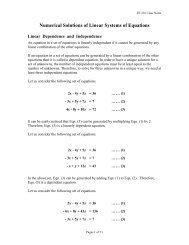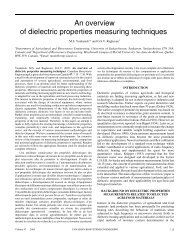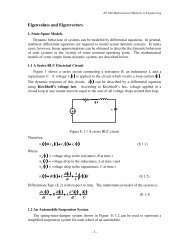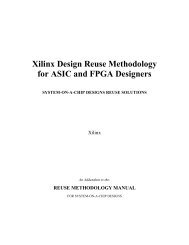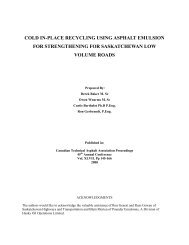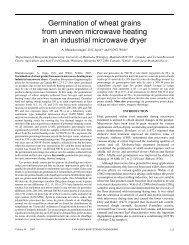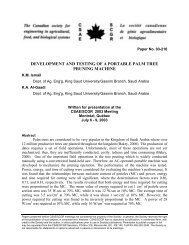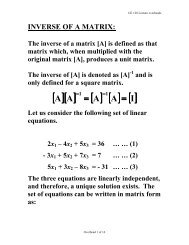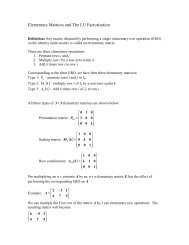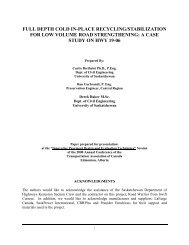Microbial survival and heat generation during online sterilization of ...
Microbial survival and heat generation during online sterilization of ...
Microbial survival and heat generation during online sterilization of ...
You also want an ePaper? Increase the reach of your titles
YUMPU automatically turns print PDFs into web optimized ePapers that Google loves.
Fig. 3. Sources <strong>of</strong> <strong>heat</strong> losses/gain for the entire <strong>sterilization</strong> system.( )q = MC T − Te pe ie oe( )q = U A T − Tt t t ia a( )q = U A T − Tb b b i a( )q = U A T − Tw w w m aqr = qgb+ qgt+ qgwwhere:A b = surface area <strong>of</strong> the reactor bottom (m 2 ),A t = surface area <strong>of</strong> the reactor top (m 2 ),A w = surface area <strong>of</strong> reactor outer walls (m 2 ),C pe = specific <strong>heat</strong> <strong>of</strong> effluent (kJ kg -1 K -1 ),M = flow rate <strong>of</strong> effluent (kg/h),(2)(3)(4)(5)(6)U wq gb = rate <strong>of</strong> <strong>heat</strong> gained by reactor bottom(kJ/h),q gt = rate <strong>of</strong> <strong>heat</strong> gained by reactor top (kJ/h),q gw = rate <strong>of</strong> <strong>heat</strong> gained by reactor walls(kJ/h),T a = ambient air temperature (K),T i = inlet temperature <strong>of</strong> cheese whey (K),T ia = temperature <strong>of</strong> air entrapped in headspace <strong>of</strong> reactor (K),T ie = inlet temperature <strong>of</strong> effluent (K),T m = mean temperature <strong>of</strong> cheese whey (K),T oe = outlet temperature <strong>of</strong> effluent (K),U b = overall <strong>heat</strong> transfer coefficient <strong>of</strong>reactor bottom (kJ m -2 h -1 K -1 ),U t = overall <strong>heat</strong> transfer coefficient <strong>of</strong>reactor top (kJ m -2 h -1 K -1 ), <strong>and</strong>= overall <strong>heat</strong> transfer coefficient <strong>of</strong> reactor walls(kJ m -2 h -1 K -1 ).The rate <strong>of</strong> <strong>heat</strong> gained by reactor top, bottom <strong>and</strong> walls iscalculated from Eqs. 7 -9.qqqgtgbgw( 2−1 )mtcptT T=∆tmbcbtT2 − T1=∆tmwcwT2 − T1=∆t( )( )where:C bt = specific <strong>heat</strong> <strong>of</strong> bottom material <strong>of</strong> reactor(kJ kg -1 K -1 ),C pt = specific <strong>heat</strong> <strong>of</strong> top material <strong>of</strong> reactor (kJ kg -1 K -1 ),C w = specific <strong>heat</strong> <strong>of</strong> wall material <strong>of</strong> reactor (kJ kg -1 K -1 ),T 1 = initial temperature (K),T 2 = final temperature (K),∆t = time interval (h),m b = mass <strong>of</strong> bottom <strong>of</strong> reactor (kg),m t = mass <strong>of</strong> top <strong>of</strong> reactor (kg), <strong>and</strong>= mass <strong>of</strong> walls <strong>of</strong> reactor (kg).m w(7)(8)(9)The terms m t , m b , <strong>and</strong> m w are calculated from Eqs. 10 - 12.m= A d ρt t t t(10)m= A d ρb b b b(11)Fig. 4. Heat transfer coefficients.mw = Adw Lwρwwhere:A dw = cross-sectional area <strong>of</strong> cylinder (m 2 ) ,d b = thickness <strong>of</strong> reactor bottom (m),d t = thickness <strong>of</strong> reactor top (m),L w = characteristic length, height <strong>of</strong> reactor (m),ρ b = density <strong>of</strong> material <strong>of</strong> reactor bottom (kg/m 3 ),ρ t = density <strong>of</strong> material <strong>of</strong> reactor top (kg/m 3 ), <strong>and</strong>ρ w = density <strong>of</strong> the material <strong>of</strong> reactor walls (kg/m 3 ).The cross-sectional area <strong>of</strong> the cylinder is calculated as:2 2( )A = π r − rdw o i(12)(13)3.4LE GÉNIE DES BIOSYSTÈMES AU CANADA SINGH <strong>and</strong> GHALY



